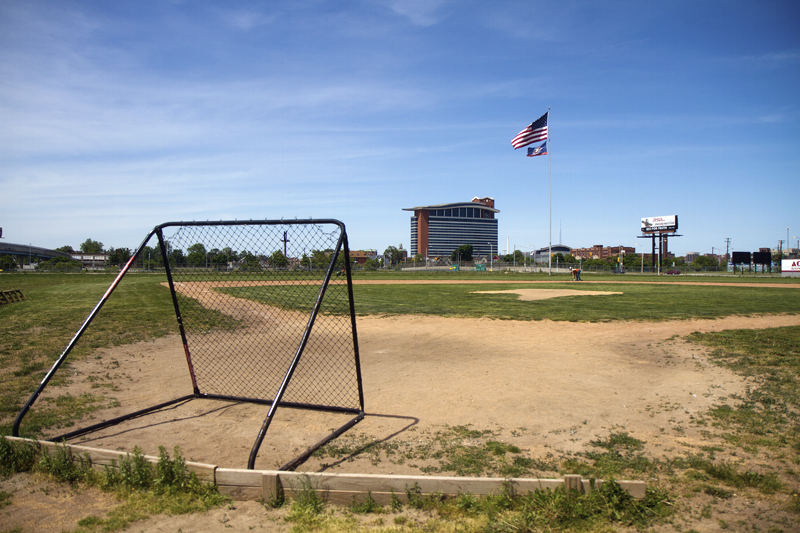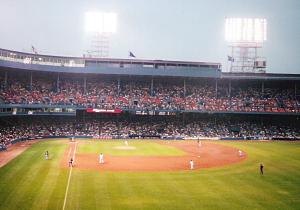
By Michael Betzold
Guest columnist
At the Feb. 2 kickoff for the Police Athletic League’s stadium project for Navin Field, not a single word about the field surface could be found in the press packets – nor in the remarks by CEO Tim Richey, Mayor Mike Duggan, Police Chief James Craig, Sen. Carl Levin, Old Tiger Stadium Conservancy leader Thom Linn, or leaders of the four main foundations contributing to the project. (No one from the Navin Field Ground Crew was invited, of course.) Say no evil.
Mistakenly thinking the glorified pep rally was an actual press conference, I asked questions and pursued PAL people for answers, the crowd gasped, and soon a security guard asked me to leave.
Now, I’ve been a journalist in Detroit a long time. I am not naïve. When the power structure in Detroit closes ranks, I know everyone is expected to keep quiet. I’d even been to the city council hearings on this issue and had my one minute of public comment rudely squashed by an angry council member.
But for months I’ve kept asking a simple, legitimate question: Why artificial turf? I’m still waiting for an answer that makes any sense.
My boorish behavior at the PAL party had only a minor effect on the subsequent coverage. A few reports made a half-hearted stab at exploring the issue.
buy Sildenafil generic https://buywithoutprescriptionrxonline.com over the counter
But most news didn’t veer off script. PAL is motherhood and apple pie – and the plan for kids to play at the old ball yard is peachy keen. Channel 4’s Guy Gordon even made the claim in his on-air report on the project that artificial turf is safer for kids to play on than natural grass. Now that is what I call enterprising journalism!
Since the party ended, I’ve learned that at least one of the four major foundations underwriting PAL’s project was not informed about the synthetic surface even though it has committed well over a million dollars to the project. I’m guessing many other donors and PAL supporters didn’t know either, so that’s why PAL tried so hard not to have the matter raised at the press event.

From the start, CEO Richey has publicly dismissed concerns about the many safety issues that have surfaced as the synthetic turf industry continues to push its products. Insisting PAL had done due diligence, Richey shared his “research” with me. It wouldn’t get a passing grade on a high school class assignment. Cherry-picked journal and industry articles don’t counter extensive reports about the extent and severity of injuries, the severe heat of up to 160 degrees on turf, possible links between synthetic turf and cancer, and other environmental hazards, including exposure to lead.
Richey’s position is that no scientific research has yet conclusively proven synthetic surfaces are unsafe, and he can always find manufacturers who claim their carpets are wonderful. This must be sweet music to the ears of attorneys Geoffrey Fieger and Sam Bernstein. Visions of future lawsuits dance in their heads. To cast any doubt on Richie’s audacious claim, I’m going to share with you my secret investigative journalism method: Google it.
‘Phony’ case made for artificial turf at old Tiger Stadium field
Richey isn’t just dismissive of questions, he doesn’t mind turning expert opinion on its head. To back his assertion that natural grass can’t withstand the intensive programming PAL plans for Navin Field, Richey cites a leading expert in the field of turf management, Professor John Rogers of Michigan State University.
To investigate that claim, I pulled from my old bag of tricks another secret weapon: the telephone. In several conversations, Rogers has patiently explained to me what went down. PAL sought his opinion; he noted its skimpy maintenance budget, lack of expertise, and disinterest in caring for natural grass, and so reluctantly gave them the answer they wanted: they’d better just put down a carpet. However, Rogers – PAL’s own selected top expert, mind you – says that with proper resources committed and competent professional groundskeepers, a natural grass field could hold up under practically unlimited use by youth athletes. It would just take some more desire, commitment, expertise, and money – but not nearly as much money than would be required to put down and maintain a synthetic field.
PAL doesn’t want to hear what Rogers really believes, however. Richey is all about making a foregone conclusion sound plausible – especially now that the power structure is lined up behind the PAL project. So Richey just ignores what he doesn’t like. That bothers even some people who do normally get a seat at the table. The Lear Corporation has withdrawn its customary $50,000 annual contribution to PAL over the issue, with CEP Matthew Simoncini saying the project “is severely flawed, is a terrible use of resources, does not preserve this site and provides an unsafe playing surface for the children.”
Even if PAL’s programming is really going to last from sunrise to midnight, which seems doubtful, Richey’s answer to why PAL needs synthetic turf at the Corner boils down to this: The horror of a few football games on a muddy field in bad weather is worse than any risks associated with kids playing on and breathing in artificial turf all year long. Does this answer satisfy PAL parents? Or does it remind anyone of what Flint parents were told about their drinking water?
I’m just asking.
Sorry to spoil the party.
https://motorcitymuckraker.com/2014/06/30/in-act-of-defiance-1984-world-series-champs-gather-at-site-of-old-tiger-stadium/
Michael Betzold
Michael Betzold is a former Free Press reporter and longtime area freelance journalist. He wrote Queen of Diamonds, a history of Tiger Stadium. He lives on Detroit’s east side.

17 Responses to "Reporter removed for asking, ‘Why artificial turf at Tiger Stadium site?’"